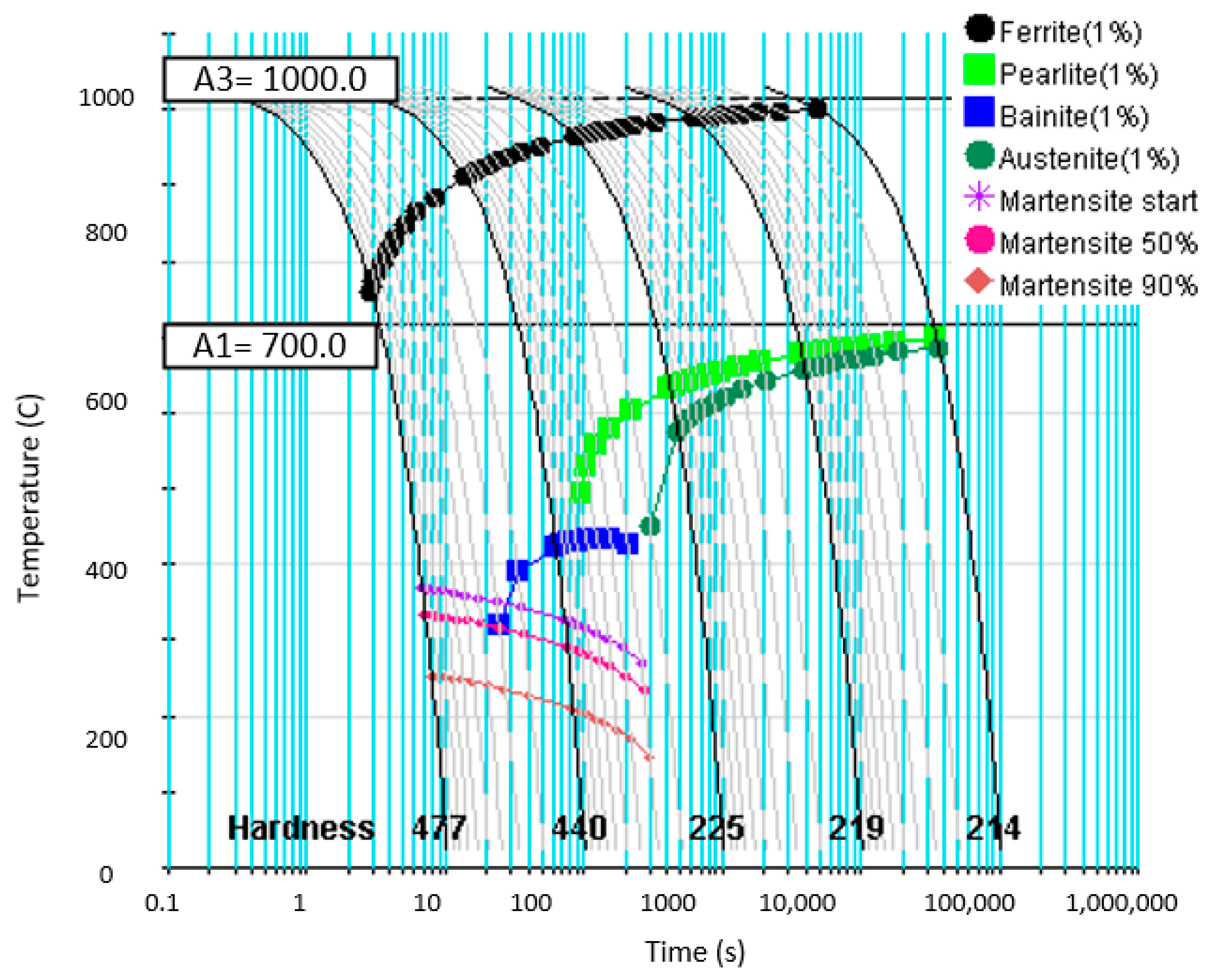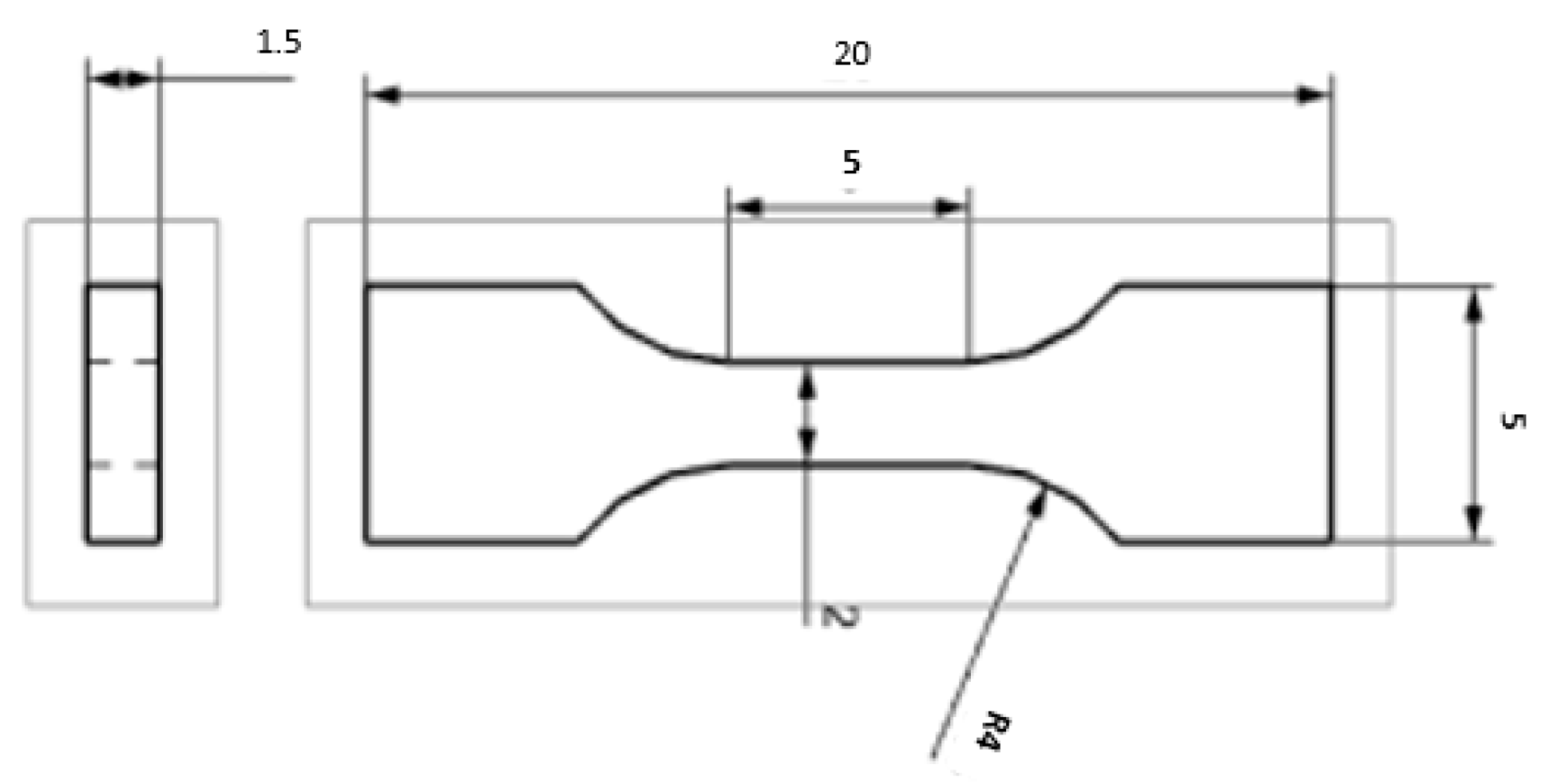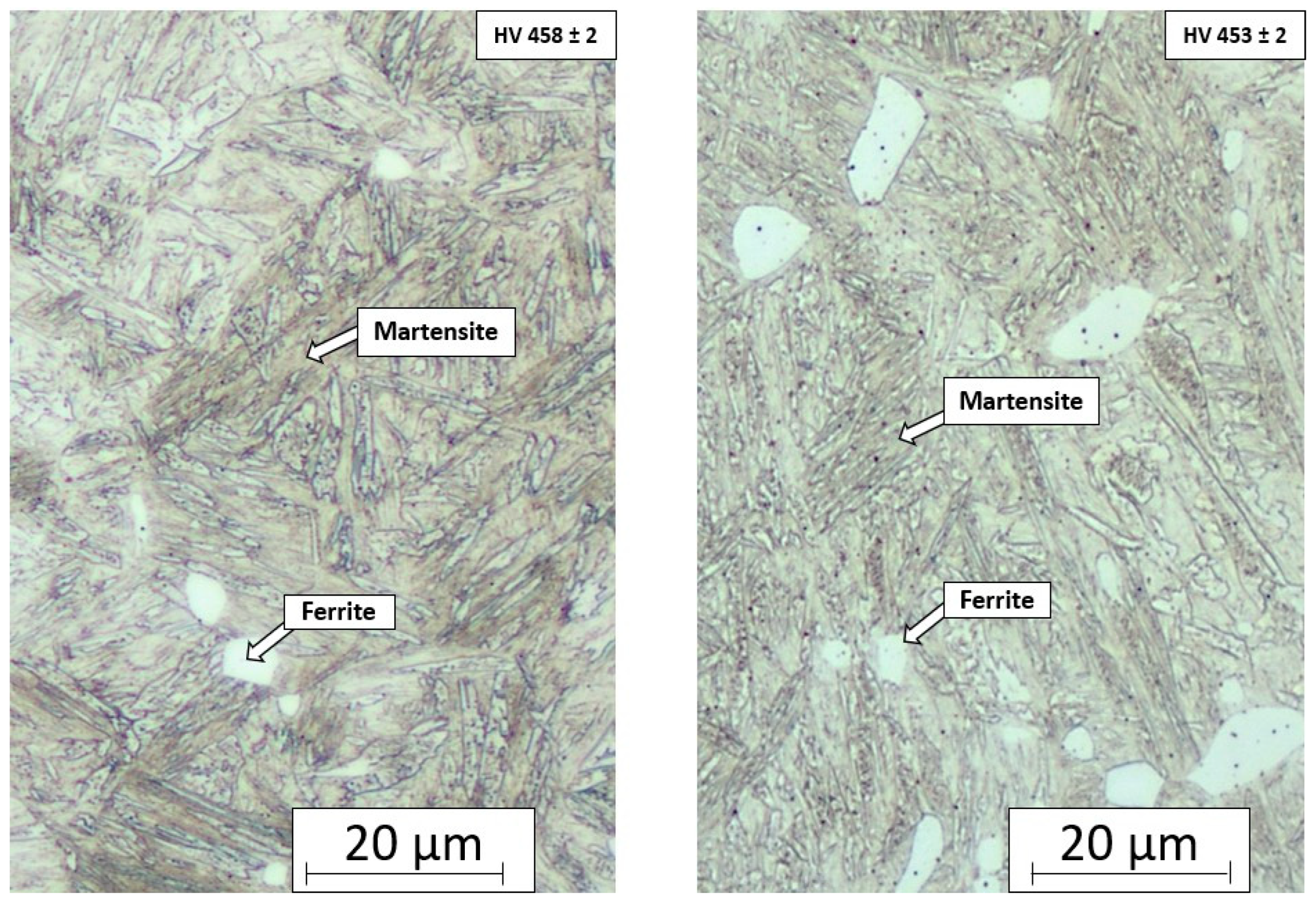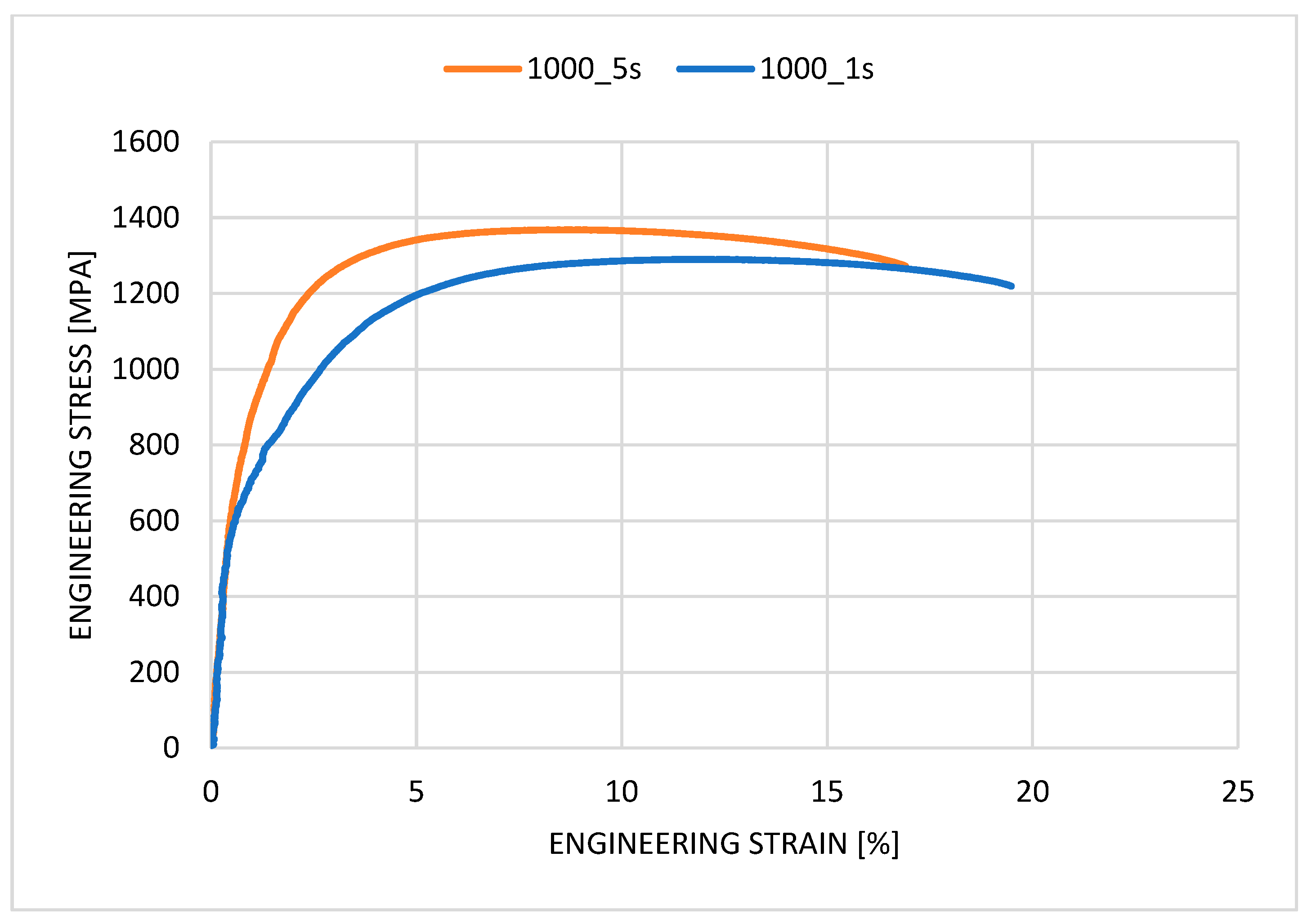Changes in Mechanical Properties of Medium Manganese Steel After Forming, Press Hardening, and Heat Treatment
Abstract
1. Introduction
2. Materials and Methods
2.1. Press Hardening
2.2. Intercritical Annealing of Omega Profiles
2.3. Evaluation Methods
3. Results
Intercritical Annealing (IA)
4. Discussion
5. Conclusions
- After press hardening, a predominantly martensitic microstructure was achieved.
- The ultimate strength of the processed material was approximately 1350 MPa, and the surface hardness of the samples reached 350 HV10.
- The ductility of the material after press hardening was measured at 19%.
- Intercritical annealing with heating between Ac1 and Ac3 resulted in a change in the microstructure but did not result in a noticeable shift in the ductility.
- Of the annealed experimental steel samples, the sample annealed at 800 °C had the highest ultimate strength, reaching 1262 MPa, and the ductility of this particular sample was measured to be 12.2%.
- In contrast, the sample annealed at 750 °C reached a ductility of more than 16%, but the strength was 1163 MPa.
Author Contributions
Funding
Institutional Review Board Statement
Informed Consent Statement
Data Availability Statement
Acknowledgments
Conflicts of Interest
References
- Baldassarre, B.; Maury, T.; Mathieux, F.; Garbarino, E.; Antonoppoulos, I.; Sala, S. Drivers and Barriers to the Circular Economy Transition: The Case of Recycled Plastics in the Automotive Sector in the European Union. Procedia CIRP 2015, 105, 37–42. [Google Scholar] [CrossRef]
- Gohoungodji, P.; Bernadine, N.A.; Latulippe, J.-K.; Matos, A.L. What stops the automotive industry from going green? A systematic review of barriers to green innovation in the automotive industry. J. Clean. Prod. 2020, 277, 6. [Google Scholar] [CrossRef]
- Li, S.; Luo, H. Medium-Mn steels for hot forming application in the automotive industry. Int. J. Miner. Metall. Mater. 2021, 28, 741–753. [Google Scholar] [CrossRef]
- Shi, D.; Watanabe, K.; Naito, J.; Funada, K.; Yasui, K. Design optimization and application of hot-stamped B pillar with local patchwork blanks. Thin Walled Struct. 2022, 170, 108523. [Google Scholar] [CrossRef]
- Schmitt, J.-H.; Iung, T. New developments of advanced high-strength steels for automotive applicationsNouveaux développements dans le domaine des aciers à très haute résistance pour les applications automobiles. Comptes Rendus Phys. 2018, 19, 641–656. [Google Scholar] [CrossRef]
- Sedaghat-Nejad, R.; Shahverdi, H.; Askari-Paykani, M. Introduction and mechanical evaluation of a novel 3rd-generation medium manganese AHSS with 86 GPa% of PSE. Mater. Sci. Eng. A 2022, 843, 143104. [Google Scholar] [CrossRef]
- Achtelik, T.; Herstatt, C.; Tiwari, R. System Orientation as an Enabler for Sustainable Frugal Engineering: Insights from Automotive Material Development. Procedia CIRP 2023, 116, 119–124. [Google Scholar] [CrossRef]
- Letyagina, E. On Assessing the Impact of Automotive Transport on the Environment of Urban Agglomerations Using the Krasnoyarsk Territory as an Example. Transp. Res. Procedia 2023, 68, 505–510. [Google Scholar] [CrossRef]
- Lin, C.; Chu, G.; Sun, L.; Chen, G.; Liu, P.; Sun, W. Radial hydro-forging bending: A novel method to reduce the springback of AHSS tubular component. Int. J. Mach. Tools Manuf. 2021, 160, 103650. [Google Scholar] [CrossRef]
- Jia, G.; Li, Y.; Ding, W. Alloy composition and process design based on thermodynamic and kinetic simulation: The case of medium Mn steel. Calphad 2023, 82, 102601. [Google Scholar] [CrossRef]
- Venturato, G.; Novella, M.; Bruschi, S.; Ghiotti, A.; Shivpuri, R. Effects of Phase Transformation in Hot Stamping of 22MnB5 High Strength Steel. Procedia Eng. 2017, 183, 316–321. [Google Scholar] [CrossRef]
- Ye, Q.; Han, G.; Xu, Z.; Cao, Z.; Qiao, L.; Yan, Y. Effect of a two-step annealing process on deformation-induced transformation mechanisms in cold-rolled medium manganese steel. Mater. Sci. Eng. A 2022, 831, 13. [Google Scholar] [CrossRef]
- Wang, Z.; Guo, X.; Hanlin, D.; Zhang, Y.; Xiang, C. Research on Hot Stamping-Carbon Partition-Intercritical Annealing Process of Medium Manganese Steel. Materials 2023, 16, 576. [Google Scholar] [CrossRef]
- Hu, B.; Luo, H. A novel two-step intercritical annealing process to improve mechanical properties of medium Mn steel. Acta Mater. 2019, 176, 250–263. [Google Scholar] [CrossRef]
- Krbata, M.; Krizan, D.; Eckert, M.; Kaar, S.; Dubec, A.; Ciger, R. Austenite Decomposition of a Lean Medium Mn Steel Suitable for Quenching and Partitioning Process: Comparison of CCT and DCCT Diagram and Their Microstructural Changes. Materials 2022, 15, 1753. [Google Scholar] [CrossRef]
- Mori, K.; Bariani, P.; Behrens, B.-A.; Brosius, A.; Bruschi, S.; Maeno, T.; Merklein, M.; Yanagimoto, J. Hot stamping of ultra-high strength steel parts. CIRP Ann. 2017, 66, 755–777. [Google Scholar] [CrossRef]
- Sugimoto, K.-I.; Sato, S.-H.; Kobayashi, J.; Srivastava, A.K. Effects of Cr and Mo on Mechanical Properties of Hot-Forged Medium Carbon TRIP-Aided Bainitic Ferrite Steels. Materials 2019, 9, 1066. [Google Scholar] [CrossRef]
- Cao, W.; Wang, C.; Shi, J.; Wang, M.Q.; Hui, W.J.; Dong, H. Microstructure and mechanical properties of Fe–0.2C–5Mn steel processed by ART-annealing. Mater. Sci. Eng. A 2011, 528, 6661–6666. [Google Scholar] [CrossRef]
- Mohapatra, S.; Mandal, A.; Poojari, G.; Das, S.; Das, K. Influence of intercritical annealing temperature on microstructure, microtexture, and tensile behavior of TRIP-assisted medium manganese steel. Materialia 2023, 28, 101781. [Google Scholar] [CrossRef]
- Krbaťa, M.; Barényi, I.; Eckert, M.; Krizan, D.; Kaar-Schickonger, S.; Breznicka, A. Hot deformation analysis of lean medium-manganese 0.2C3Mn1.5Si steel suitable for quenching et partitioning process. Kov. Mater.-Met. Mater. 2021, 59, 379–390. [Google Scholar] [CrossRef]
- Jirková, H.; Vrtáček, J.; Pekovič, M.; Janda, T.; Kučerová, L. Influence of Chromium and Niobium on the Press-Hardening Process of Multiphase Low-Alloy TRIP Steels. Maerials Sci. Forum 2021, 1016, 636–641. [Google Scholar] [CrossRef]
- Leták, R.; Jirková, H.; Kučerová, L.; Jeníček, Š.; Volák, J. Effect of Forming and Heat Treatment Parameters on the Mechanical Properties of Medium Manganese Steel with 5% Mn. Materials 2023, 16, 4340. [Google Scholar] [CrossRef]
- Votava, F.; Jirková, H.; Kučerová, L.; Jeníček, Š. Study of Transition Areas in Press-Hardened Steels in a Combined Tool for Hot and Cold Forming. Materials 2023, 16, 442. [Google Scholar] [CrossRef] [PubMed]
- Votava, F.; Vrtáček, J.; Sýkora, J.; Weinar, M.; Jirková, H. Design of a Combined Tool for Sheet Tailoring during Press Hardening. Eng. Proc. 2022, 26, 442. [Google Scholar] [CrossRef]
- Kozłowska, A.; Morawiec, M.; Petrov, R.; Grajcar, A. Microstructure evolution of medium manganese Al-alloyed steel manufactured by double-step intercritical annealing: Effects of heating and cooling rates. Mater. Charact. 2023, 199, 112816. [Google Scholar] [CrossRef]
- Varanasi, R.S.; Lipiňska-Chwałek, M.; Mayer, J.; Gault, B.; Ponge, D. Mechanisms of austenite growth during intercritical annealing in medium manganese steels. Scr. Mater. 2023, 206, 114228. [Google Scholar] [CrossRef]
- Kuzmina, M.; Ponge, D.; Raabe, D. Grain boundary segregation engineering and austenite reversion turn embrittlement into toughness: Example of a 9 wt.% medium Mn steel. Acta Mater. 2015, 86, 182–192. [Google Scholar] [CrossRef]
- Yadav, M.K.; Kumar, D.; Kumar, N.; Bandyopadhyay, T.K. Hot-rolled Al-added medium Mn steel (Fe-8Mn-2.85Al-1Si-0.2C): Microstructural evolution and tensile behavior. Materialia 2023, 29, 101790. [Google Scholar] [CrossRef]
- Wu, Z.; Jing, C.; Feng, Y.; Li, Z.; Lin, T.; Zhao, J.; Liu, L. Effect of a new pretreatment-Q&P process on the microstructure and mechanical properties of light-weight Al-containing medium-Mn steels. Mater. Sci. Eng. A 2023, 862, 144468. [Google Scholar] [CrossRef]
- Kozłowska, A.; Morawiec, M.; Skowronek, A.; Grajcar, A.; Matus, K.; Nuckowski, P.M. Enhancing mechanical properties of hot-rolled Al-alloyed medium-Mn steel by novel double-step intercritical annealing. Mater. Sci. Eng. A 2023, 865, 144650. [Google Scholar] [CrossRef]
- Kooiker, H.; Perdahcıoğlu, E.S.; van den Boogaard, A.H. Combined athermal and isothermal martensite to austenite reversion kinetics, experiment, and modeling. Mater. Des. 2020, 196, 109124. [Google Scholar] [CrossRef]
- Xu, H.F.; Zhao, J.; Cao, W.; Shi, J.; Wang, C.; Wang, C.; Li, J.; Dong, H. Heat treatment effects on the microstructure and mechanical properties of a medium manganese steel (0.2C–5Mn). Mater. Sci. Eng. A 2012, 532, 43544. [Google Scholar] [CrossRef]
- Çavuşoğlu, O.; Çavuşoğlu, O.; Yılmazoğlu, A.G.; Üzel, U.; Aydın, H.; Güral, A. Microstructural features and mechanical properties of 22MnB5 hot stamping steel in different heat treatment conditions. J. Mater. Res. Technol. 2020, 9, 10901–10908. [Google Scholar] [CrossRef]
- de Costa, L.D.L.; Brito, A.M.G.; Rosiak, A.; Schaeffer, L. Study of the applicability of 22MnB5 sheet metal as protective masks to improve tool life in hot forging process. Int. J. Adv. Manuf. Technol. 2020, 107, 39–47. [Google Scholar] [CrossRef]
- Zhou, J.; Wang, B.; Huang, M.; Cui, D. Effect of hot stamping parameters on the mechanical properties and microstructure of cold-rolled 22MnB5 steel strips. Int. J. Miner. Metall. Mater. 2014, 21, 544–555. [Google Scholar] [CrossRef]
- Grajcar, A.S.P.; Wozniak, D. Thermomechanically rolled medium-Mn steels containing retained austenite. Arch. Metall. Mater. 2014, 59, 4. [Google Scholar] [CrossRef]
- Zou, Y.; Ding, H.; Zhang, Y.; Tang, Z. Microstructural evolution and strain hardening behavior of a novel two-stage warm rolled ultra-high strength medium Mn steel with heterogeneous structures. Int. J. Plast. 2022, 151, 103212. [Google Scholar] [CrossRef]
- Yang, F.; Luo, H.; Hu, C.; Pu, E.; Dong, H. Effects of intercritical annealing process on microstructures and tensile properties of cold-rolled 7Mn steel. Mater. Sci. Eng. A 2017, 685, 115–122. [Google Scholar] [CrossRef]
- Zhou, L.; Xu, Y.; Mao, X.; Yang, G.; Bao, S.; Zhao, G.; Miao, X. Influence of Austenitizing Parameters on the Microstructures and Mechanical Properties of 22MnB5 Hot Stamping Steel Produced by TSCR Process. Phys. Met. Metallogr. 2020, 121, 1326–1333. [Google Scholar] [CrossRef]
- Chandan, A.; Mishra, G.; Kishore, K.; Bansal, G.; Sahoo, B.; Jena, P.; Kumar, S.; Rai, S.; Saha, R.; Kundu, S.; et al. Evading the strength-ductility compromise in medium manganese steel by a novel low temperature warm rolling treatment. Mater. Charact. 2023, 206, 113445. [Google Scholar] [CrossRef]
- Mou, Y.; Li, Z.; Zhang, X.; Misra, D.; He, L.; Li, H. Design of an Effective Heat Treatment Involving Intercritical Hardening for High Strength/High Elongation of 0.2C–3Al–(6–8.5)Mn–Fe TRIP Steels: Microstructural Evolution and Deformation Behavior. Metals 2019, 9, 1275. [Google Scholar] [CrossRef]







| Chem. Comp. | C | Mn | Al | Si | Cr | Cu | Nb | Ni | P | S |
|---|---|---|---|---|---|---|---|---|---|---|
| wt. % | 0.21 | 3.06 | 2.15 | 0.57 | 0.16 | 0.069 | 0.057 | 0.048 | 0.006 | 0.003 |
| Hardening Time in the Tool [s] | Ultimate Strength (Rm) [MPa] | Elongation (A) [%] | Hardness HV10 [-] |
|---|---|---|---|
| 1 | 1326 ± 15 | 19.1 ± 1.1 | 459 ± 2 |
| 5 | 1392 ± 35 | 18.3 ± 0.2 | 453 ± 5 |
| Hardening Time in the Tool [s] | Annealing Temperature [°C] | Ultimate Strength (Rm) [MPa] | Elongation (A) [%] | Hardness HV10 [-] |
|---|---|---|---|---|
| 5 | 700 | 1037 ± 34 | 16 ± 1 | 260 ± 4 |
| 5 | 750 | 1163 ± 69 | 16.5 ± 3.5 | 254 ± 4 |
| 5 | 800 | 1262 ± 6 | 12.2 ± 0.4 | 356 ± 7 |
Disclaimer/Publisher’s Note: The statements, opinions and data contained in all publications are solely those of the individual author(s) and contributor(s) and not of MDPI and/or the editor(s). MDPI and/or the editor(s) disclaim responsibility for any injury to people or property resulting from any ideas, methods, instructions or products referred to in the content. |
© 2025 by the authors. Licensee MDPI, Basel, Switzerland. This article is an open access article distributed under the terms and conditions of the Creative Commons Attribution (CC BY) license (https://creativecommons.org/licenses/by/4.0/).
Share and Cite
Leták, R.; Kučerová, L.; Jirková, H.; Jeníček, Š.; Votava, F. Changes in Mechanical Properties of Medium Manganese Steel After Forming, Press Hardening, and Heat Treatment. Materials 2025, 18, 1196. https://doi.org/10.3390/ma18061196
Leták R, Kučerová L, Jirková H, Jeníček Š, Votava F. Changes in Mechanical Properties of Medium Manganese Steel After Forming, Press Hardening, and Heat Treatment. Materials. 2025; 18(6):1196. https://doi.org/10.3390/ma18061196
Chicago/Turabian StyleLeták, Radek, Ludmila Kučerová, Hana Jirková, Štěpán Jeníček, and Filip Votava. 2025. "Changes in Mechanical Properties of Medium Manganese Steel After Forming, Press Hardening, and Heat Treatment" Materials 18, no. 6: 1196. https://doi.org/10.3390/ma18061196
APA StyleLeták, R., Kučerová, L., Jirková, H., Jeníček, Š., & Votava, F. (2025). Changes in Mechanical Properties of Medium Manganese Steel After Forming, Press Hardening, and Heat Treatment. Materials, 18(6), 1196. https://doi.org/10.3390/ma18061196








